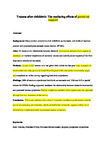Birth trauma: the mediating effects of perceived support
| dc.contributor.author | Baptie, G | |
| dc.contributor.author | Andrade, J | |
| dc.contributor.author | Bacon, AM | |
| dc.contributor.author | Norman, Alyson | |
| dc.date.accessioned | 2020-10-12T14:46:01Z | |
| dc.date.available | 2020-10-12T14:46:01Z | |
| dc.date.issued | 2020-10-02 | |
| dc.identifier.issn | 0969-4900 | |
| dc.identifier.issn | 2052-4307 | |
| dc.identifier.uri | http://hdl.handle.net/10026.1/16522 | |
| dc.description.abstract |
<jats:sec><jats:title>Background</jats:title><jats:p> Many women experience their childbirth as traumatic, and 4-6% of mothers present with postnatal post-traumatic stress disorder. </jats:p></jats:sec><jats:sec><jats:title>Aims</jats:title><jats:p> To measure the relationship between obstetric intervention, perceived support in childbirth and mothers' experiences of postnatal trauma, and to identify salient aspects of the birth experience that are considered traumatic. </jats:p></jats:sec><jats:sec><jats:title>Methods</jats:title><jats:p> A total of 222 women in their first year postpartum were recruited between October and December 2018 via local mother and baby groups in southwest England (UK) and online social media pages. They completed an online survey regarding their birth experience. Further insight into mother's birth experiences was garnered through free-text responses in the survey. </jats:p></jats:sec><jats:sec><jats:title>Results</jats:title><jats:p> Overall, 29% of mothers experienced a traumatic birth and 15% met full or partial criteria for post-traumatic stress disorder. Feeling supported mediated the relationship between obstetric intervention and postnatal trauma symptoms. </jats:p></jats:sec><jats:sec><jats:title>Conclusions</jats:title><jats:p> This study reinforces the value of supportive healthcare professionals and the power of a nurturing environment, which can buffer the potentially negative effects of an obstetrically complicated birth on postnatal trauma symptoms. </jats:p></jats:sec> | |
| dc.format.extent | 724-730 | |
| dc.language | en | |
| dc.language.iso | en | |
| dc.publisher | Mark Allen Group | |
| dc.title | Birth trauma: the mediating effects of perceived support | |
| dc.type | journal-article | |
| plymouth.issue | 10 | |
| plymouth.volume | 28 | |
| plymouth.publication-status | Published | |
| plymouth.journal | British Journal of Midwifery | |
| dc.identifier.doi | 10.12968/bjom.2020.28.10.724 | |
| plymouth.organisational-group | /Plymouth | |
| plymouth.organisational-group | /Plymouth/Faculty of Health | |
| plymouth.organisational-group | /Plymouth/REF 2021 Researchers by UoA | |
| plymouth.organisational-group | /Plymouth/REF 2021 Researchers by UoA/UoA04 Psychology, Psychiatry and Neuroscience | |
| plymouth.organisational-group | /Plymouth/Research Groups | |
| plymouth.organisational-group | /Plymouth/Research Groups/Centre for Brain, Cognition and Behaviour (CBCB) | |
| plymouth.organisational-group | /Plymouth/Research Groups/Centre for Brain, Cognition and Behaviour (CBCB)/Behaviour | |
| plymouth.organisational-group | /Plymouth/Users by role | |
| plymouth.organisational-group | /Plymouth/Users by role/Academics | |
| dcterms.dateAccepted | 2020-09-15 | |
| dc.rights.embargodate | 2021-7-6 | |
| dc.identifier.eissn | 2052-4307 | |
| dc.rights.embargoperiod | Not known | |
| rioxxterms.versionofrecord | 10.12968/bjom.2020.28.10.724 | |
| rioxxterms.licenseref.uri | http://www.rioxx.net/licenses/all-rights-reserved | |
| rioxxterms.licenseref.startdate | 2020-10-02 | |
| rioxxterms.type | Journal Article/Review |


